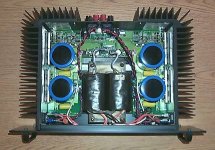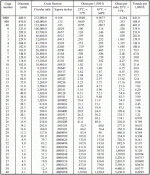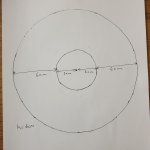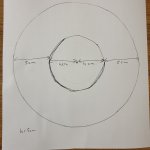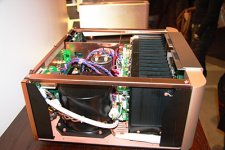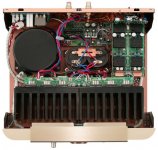Hi. We will build a high end audio amplifier and think 500VA transformer will be enough. And also we want to build another 50w transformer. We can supply sheets in the picture attached. We want to build with UI sheets. Please check pictures and could anyone tell which of them and how many pcs of them will be suitable. Their gauss is 10000-12000 .Thanks in advance. Best regards Veys

nice, how much cost per kilogram of core and what minimum order quantity?
what is lamination thickness, is that grain oriented?
what is lamination thickness, is that grain oriented?
About 2 usd per kilogram and minimum order about 20kg i think. 0.5mm thickness. And yes oriented. I do not have a calculation i am not engineer. Can anyone help about formulas?
your core area in square centimeters, x 0.95(stacking factor) call this A,
then your turns per volt becomes 42/A, then for wire size, you can start at 500 circular mils per ampere, if more space is available you can choose wires one size or so higher..
ARRL wire tables are available in the net to download...
cost seems reasonable, but i bet shipping will be a killer...
then your turns per volt becomes 42/A, then for wire size, you can start at 500 circular mils per ampere, if more space is available you can choose wires one size or so higher..
ARRL wire tables are available in the net to download...
cost seems reasonable, but i bet shipping will be a killer...
Attachments
Hi. Thank for answering.42 seems the formula. I think I will build toroidal transformer because I want the lowest noise and lightweight amplifier for waf.
There is 10000 and 20000 gauss cores in my country but not sure how important gauss is. For example for 600va transformer . 20k ones very expensive 5.6usd per kilo and 10k 1.75 per kilo. We want to build high end amplifiers but cost is too much.
And another question ,I checked toroidal area formulas and see that area of core is determined by height times R- R1 . What is ideal toroidal transformer R ratio? Can we make very little hole toroidal core to increase power density?Does it cause increased distortion or humm? Is there an optimum point for toroidal core dimensions? Regards
There is 10000 and 20000 gauss cores in my country but not sure how important gauss is. For example for 600va transformer . 20k ones very expensive 5.6usd per kilo and 10k 1.75 per kilo. We want to build high end amplifiers but cost is too much.
And another question ,I checked toroidal area formulas and see that area of core is determined by height times R- R1 . What is ideal toroidal transformer R ratio? Can we make very little hole toroidal core to increase power density?Does it cause increased distortion or humm? Is there an optimum point for toroidal core dimensions? Regards
The basic transformers' formula is here for example: https://www.diyaudio.com/community/...double-c-core-transformer.234866/post-3469063
You should base the calculation on the worst case situation, ie. 245V in most of Europe and affiliated countries.
Gauss is an old, deprecated unit: formula's are based on SI system, where 1 Tesla = 10,000gauss.
The ideal cross section shape is round, but it is rarely achievable, except in R-cores. The next best thing is a square. Other dimensions have no influence on the volt/turn constant, they simply change the magnetizing inductance and the leakage inductance.
To avoid magnetic leaks and noise, stay 10 or 20% below the nominal saturation induction (for the worst case)
You should base the calculation on the worst case situation, ie. 245V in most of Europe and affiliated countries.
Gauss is an old, deprecated unit: formula's are based on SI system, where 1 Tesla = 10,000gauss.
The ideal cross section shape is round, but it is rarely achievable, except in R-cores. The next best thing is a square. Other dimensions have no influence on the volt/turn constant, they simply change the magnetizing inductance and the leakage inductance.
To avoid magnetic leaks and noise, stay 10 or 20% below the nominal saturation induction (for the worst case)
Hi. For 18cm toroidal core which design is better ? First ones height is 6cm and second ones height 5cm. Please check pictures attached .How can we decide the dimensions? Is there any golden ratio for toroidal transformers ?
Attachments
Last edited:
The first one is "fatter", and should require less material, copper and iron, but the magnetic path length varies heavily between the inner part of the iron, and the outside. This means that it will partially saturate more quickly.
A slimmer toroid will not have this problem, but it will require more iron for a given power, thus higher iron losses and higher reluctance of the magnetic circuit leading to a higher magnetizing current.
I have no knowledge of a single "golden ratio", but it possible to find studies of the subject, like this one for example: https://core.ac.uk/download/pdf/80647289.pdf
Pretty dense stuff, but if you manage to absorb and use it, you will arrive at a pretty optimal design
A slimmer toroid will not have this problem, but it will require more iron for a given power, thus higher iron losses and higher reluctance of the magnetic circuit leading to a higher magnetizing current.
I have no knowledge of a single "golden ratio", but it possible to find studies of the subject, like this one for example: https://core.ac.uk/download/pdf/80647289.pdf
Pretty dense stuff, but if you manage to absorb and use it, you will arrive at a pretty optimal design
Hi Veysel.Marantz MA9S2 has this toroid which is tall. Please check picture attached. Its dimensions seems about 130mm wide and more than 150mm high if comparing to its body size (about 450mm width and 200mm height)
It seems stell core is slim but high.
It seems stell core is slim but high.
Attachments
Difficult to tell, but one thing is certain: the cross section should be ~square, or thereabout. It will limit the mean turn length and reduce the likelihood of stray fields.
Other than that, things become much more complicated and less clear-cut.
Extreme variations are certainly detrimental, but reasonable ratios are much more difficult to evaluate objectively, and the best case may vary according to the objectives: do you want to reduce the idle power, increase the efficiency for the full load, get the best regulation?
This is complicated, and there is no simple single answer
Other than that, things become much more complicated and less clear-cut.
Extreme variations are certainly detrimental, but reasonable ratios are much more difficult to evaluate objectively, and the best case may vary according to the objectives: do you want to reduce the idle power, increase the efficiency for the full load, get the best regulation?
This is complicated, and there is no simple single answer
Hi. I am looking for lowest noise and distortion as possible transformer. I think i do not care about 3-5% more efficiency . I will build high power high end amplifier like Marantz ma9s2. I am copying Marantz now. I think I can build a slimmer toroidal transformer which have square cross.Maybe Marantz could not find space in amplifier and did tall and narrow transformer.
Is there any advantage to use high gauss ( tesla) stell for sound quality.( i heard it is important for tube amplifier output transformers but I will not use it for signal ) I read that some toroidal transformer companies in my country write in web sites they use high gauss stell but i do not think so.
Is there any advantage to use high gauss ( tesla) stell for sound quality.( i heard it is important for tube amplifier output transformers but I will not use it for signal ) I read that some toroidal transformer companies in my country write in web sites they use high gauss stell but i do not think so.
180x130x80 toroidal core
0,23mm thick 7.050 gram 20000 gauss 5.65 USD+tax/KG
0,27mm thick 7.170 gram 18000 gauss 4.85 USD+tax/KG
0,30mm thick 7.200 gram . 16000 gauss 4.25 USD+tax/KG
0.50mm thick 10000 gauss 1.75 USD+tax/KG
0,23mm thick 7.050 gram 20000 gauss 5.65 USD+tax/KG
0,27mm thick 7.170 gram 18000 gauss 4.85 USD+tax/KG
0,30mm thick 7.200 gram . 16000 gauss 4.25 USD+tax/KG
0.50mm thick 10000 gauss 1.75 USD+tax/KG
For a power transformer, the max induction of the steel only influences the number of turns. I would stay away from the 0.5mm though.
In order to minimize stray fields, the toroid should be large enough, to keep the field homogeneous, and the number of turns should be large enough to keep the peak induction 15~20% below the stated value, for worst case conditions (upper tolerance of mains voltage).
The windings should be regular and homogeneous and cover the whole of the toroid
In order to minimize stray fields, the toroid should be large enough, to keep the field homogeneous, and the number of turns should be large enough to keep the peak induction 15~20% below the stated value, for worst case conditions (upper tolerance of mains voltage).
The windings should be regular and homogeneous and cover the whole of the toroid
- Home
- Amplifiers
- Power Supplies
- UI transformer calculation
